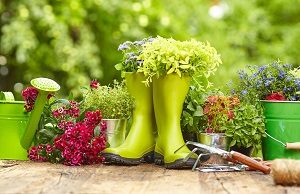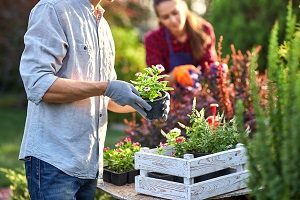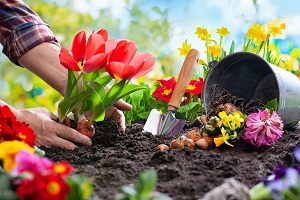If you live in a planned development, installing a flower garden has likely crossed your mind. These beauties add a sense of whimsy to every community and are more than just pleasing to the eyes. While not everyone has the skills required to install a flower garden, just about anyone can learn to do so by following a few tips.
The Foundations of Installing a Flower Garden
Here’s a history lesson for you: the term “Keeping up with the Joneses” actually started in Wilmington, NC, at the turn of the century when Pembroke Jones and his wife landscaped about 67 acres of their property. His neighbors had no hope of keeping up with the scope and beauty and, thus, the term “Keeping up with the Joneses” was introduced into our society.
This historical garden is now called the Airlie Gardens. It is a long-standing part of the culture in North Carolina to improve our immediate surroundings with beautiful plants, lavish flowers, and trees that bloom in the spring or that produce the majestic fall colors.
Having a flower garden is a basic part of HOA landscaping. It increases curb appeal and generally leads to higher property values. More than that, when you install a flower bed, you’re helping the environment. After all, who would want to live in a community with no flowers and a high rate of air pollution?
If you have been considering installing a flower garden, here are a few very simple and very basic ideas that you will want to consider before getting started: height, color, season, the size of your garden or bed, and the soil you will use. Let’s break them down one by one:
1. Consider the Height
 Flowers come in almost every height. If you are planning to have multiple plant families or species in one garden that will have differing heights, you will most likely want to plant taller flowers in the back and the shorter flowers in the front (depending on how you have designed your garden).
Flowers come in almost every height. If you are planning to have multiple plant families or species in one garden that will have differing heights, you will most likely want to plant taller flowers in the back and the shorter flowers in the front (depending on how you have designed your garden).
Most plants will indicate on the packaging how tall they will grow, so always take the plant’s height into consideration. If all of your flowers are going to bloom at the same height, you may want to consider stepping or sloping the landscaping to help produce a more vibrant view of the plants.
2. Factor in Color
Flowers will also come in almost every color imaginable. When installing a flower garden, consider what colors will work well together and what colors may complement your current landscaping. This may be a more difficult task for some.
If finding colors that complement each other is difficult, you may want to take a look at what others have done. Spend some time online looking at landscaping arrangements. Better yet, spend an evening walk through your community with the intention of noticing what your neighbors have done (and compliment them on their lawn if it is appropriate).
Visiting a local botanical garden, such as the Daniel Stowe Botanical Garden or the UNC Charlotte Botanical Gardens, is also a great place to get some ideas of what colors and plant types will work well together. While you most likely will not be planting a garden on the same scale as these botanical gardens, it is a great place to gather ideas and reliable information.
3. Take Note of the Season
 You will also want to consider the seasons when planning a garden. Different flowers will bloom at different times of the year. While the seasons into account, you will also want to consider whether the plant types are annuals, perennials, or biennials.
You will also want to consider the seasons when planning a garden. Different flowers will bloom at different times of the year. While the seasons into account, you will also want to consider whether the plant types are annuals, perennials, or biennials.
Some flowers will need to be replanted every year, while others will naturally grow back on their own every year. You may want to consider replanting for each season throughout the year. Before installing a flower garden, take some time to research what plants will grow best in each season and in what seasons your plants will be blooming.
4. Decide on a Size
There are several reasons for considering the size of the area that you are going to be working in. You will need to know the size of the garden and consider the appropriate plant spacing when determining how many of each plant species to purchase. You will also need to know the size when purchasing fertilizer, mulch, or other products for your garden. Take some time to think about the layout of the area and consider how you want to separate the garden from other landscaping areas.
5. Know Your Soil
 A flower garden is only as good as the soil it’s planted on. Before you install a flower garden, you must know what type of soil to purchase. Of course, this will also depend on the type of flowers you eventually go with.
A flower garden is only as good as the soil it’s planted on. Before you install a flower garden, you must know what type of soil to purchase. Of course, this will also depend on the type of flowers you eventually go with.
Some soils are more forgiving than others. When in doubt, ask your local supplier what kind of soil they recommend using. Something beginner-friendly is ideal.
If you want to be extra thorough, it’s a good idea to conduct a soil test. Don’t worry — it’s not as hard as it sounds. To do this, dig foot-deep holes across your site. From there, collect soil samples until you fill up a quart-sized jar. A few tablespoons from each hole should be enough. After that, you can send it to a testing lab to assess the health of your soil.
Installing a Flower Garden Made Easy
If you have been considering installing a flower garden and don’t know how to begin, these considerations should help you find your ground. These tips will not only help you “Keep up with the Joneses”, but more importantly, help enhance the beauty and integrity of your home and your community as a whole.
While it does take a good amount of time and effort, gardening can be very rewarding for anyone who tries it. It is a great way to show your pride in your home and community while simultaneously improving curb appeal. Take time to compliment your neighbors on their landscaping and let them know how much you appreciate their efforts to make their home and your community a more beautiful place to live.
Some HOAs outsource their flower bed needs to landscaping companies. Choosing the perfect vendor is often a rigorous process — one that mustn’t be taken lightly. In times like this, most associations turn to HOA management companies for help. If you find yourself in the same predicament, don’t hesitate to give us a call.
RELATED ARTICLES:
- HOA Property Maintenance: What Is Your HOA Responsible For?
- 9 Tips To Prepare HOA Community For Fall Season
- If A Tree Falls On A House, Who Is Responsibile?






